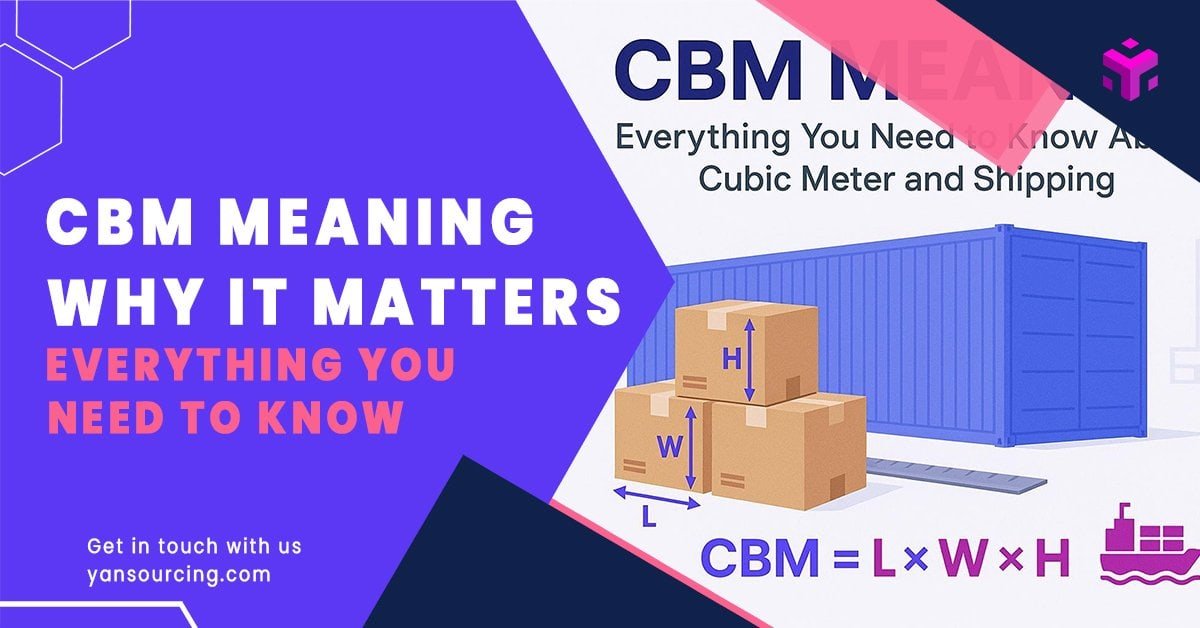
If you import by the carton, pallet, or container, CBM (cubic meter) quietly decides a lot of your costs. It determines how LCL is billed, when FCL makes sense, how air freight calculates chargeable weight, and even how many cartons realistically fit a 40’ high cube.
In my experience, getting CBM right is one of the fastest ways to lower landed cost per unit without changing your product.
This guide explains CBM end to end—definitions, exact formulas, chargeable weight by mode, container capacity realities, LCL vs FCL break‑even logic, packaging tactics that reduce CBM, and the common pitfalls that create surprise fees.
1) What CBM is and why it matters
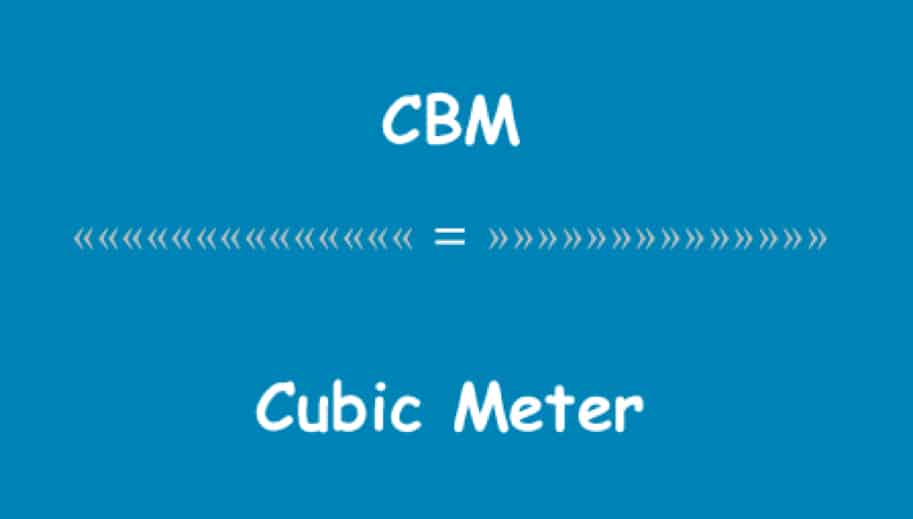
- CBM stands for cubic meter, the standard volume unit in global freight.
- Freight providers use CBM to price space: LCL sea freight charges per W/M (Weight or Measurement), and air/express use dimensional formulas to convert volume to a “chargeable weight.”
- For B2B importers, a correct CBM changes decisions like: should we ship this batch as LCL or wait to fill a 20’ FCL? Should we use air or ocean? Do we need to redesign our outer cartons to cut wasted volume?
In short: Better CBM data → better mode choice → better container utilization → lower cost per unit.
2) CBM fundamentals (with step-by-step examples)
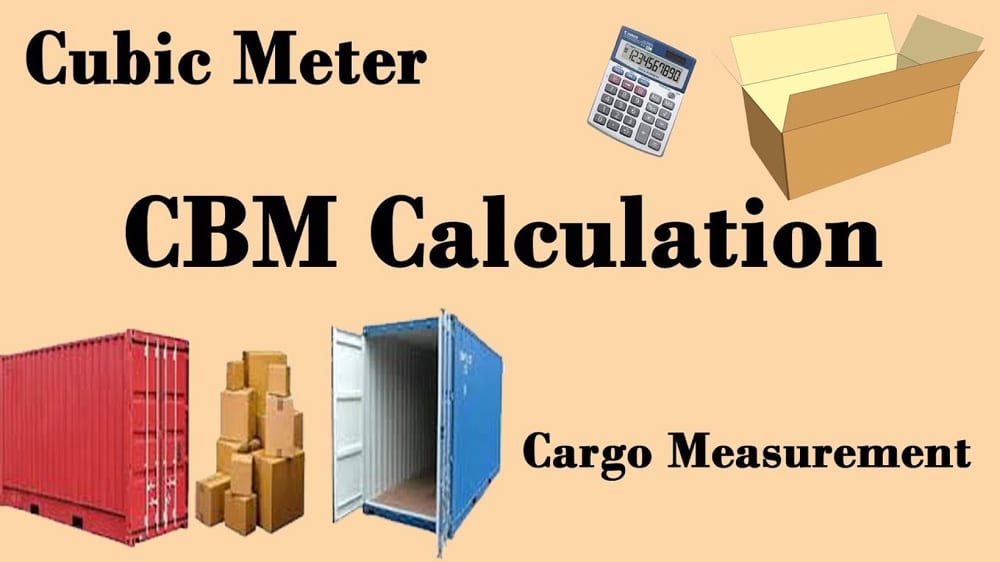
2.1 The basic formula
For rectangular cargo (cartons, crates, pallets):
CBM = Length (m) × Width (m) × Height (m)
- Always measure the outermost dimensions, including packaging and any protrusions or overhang.
- Convert centimeters to meters before multiplying: cm ÷ 100 = m.
- Record CBM to three decimals on pack lists and bookings (e.g., 0.480 m³).
Example: A carton measuring 120 × 80 × 50 cm → 1.20 × 0.80 × 0.50 m = 0.480 CBM.
2.2 Multiple identical cartons
If all cartons are the same size, calculate one CBM and multiply by quantity.
Example: 30 cartons at 62 × 42 × 36 cm
- Convert to meters: 0.620 × 0.420 × 0.360 m = 0.094 CBM per carton (rounded)
- Total CBM ≈ 30 × 0.094 = 2.820 CBM
2.3 Pallets and unit loads
When shipping pallets or shrink-wrapped stacks, measure the entire outer footprint including the pallet and any overhang. Do not sum the inside cartons for rating—carriers often rate the full unitized size.
Example: Pallet footprint 120 × 100 cm, stacked to 150 cm → 1.20 × 1.00 × 1.50 m = 1.800 CBM
2.4 Cylinders and irregular items
- Cylinder: CBM = π × (Diameter/2)² × Height.
- Irregular items: Unless the carrier accepts a specific geometry, use the bounding box (max L × W × H) for rating.
Example: Cylinder D = 1.0 m, H = 1.2 m → π × 0.5² × 1.2 ≈ 0.94 CBM.
2.5 Rounding and documentation
- Store CBM to three decimals; tariffs sometimes round up chargeable weight to the next whole kg/lb depending on mode.
- Include dimensions and weights on your packing list. For palletized loads, include the pallet height and whether there’s any overhang.
2.6 Common mistakes to avoid
- Mixing cm and m when multiplying (always convert first).
- Forgetting outer carton dimensions (using inner box size instead).
- Ignoring pallet height or overhanging cartons.
- Relying on supplier catalogs without verifying actual packed dimensions.
3) Chargeable weight rules by mode (what you’ll actually pay)
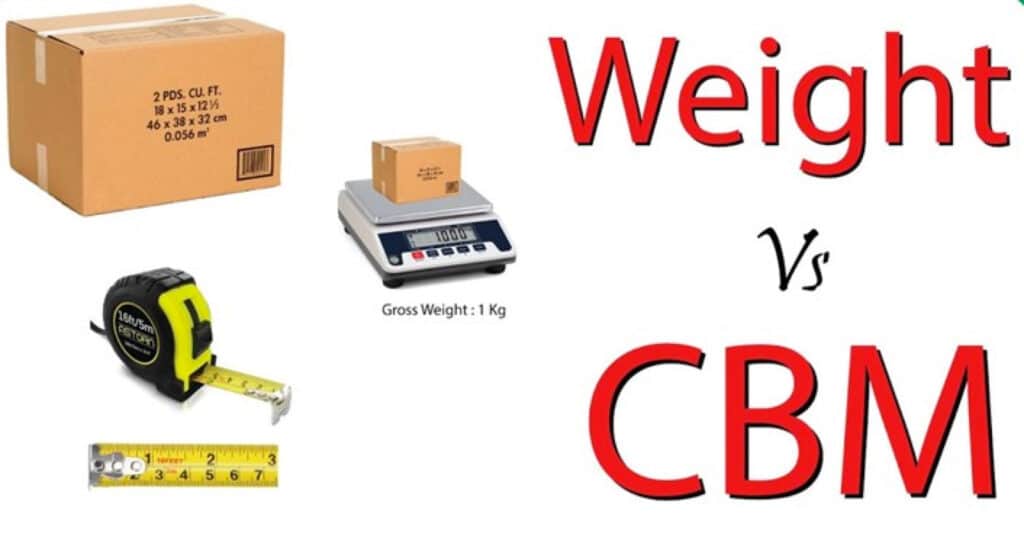
Freight is often billed on a “chargeable weight,” which is the greater of actual weight or a computed dimensional weight. The formulas differ by mode.
3.1 Air freight (general cargo)
- Standard industry convention uses a volumetric divisor of 6,000 cm³/kg. Dimensional weight (kg) = L × W × H (cm) ÷ 6,000.
- Put differently, 1 m³ equates to about 167 kg of chargeable weight.
- Carriers explain this clearly; for example, see the 2025 DHL guidance that “chargeable weight” uses a 6,000 cm³/kg divisor on its help page: DHL eCommerce Canada chargeable weight (2025). Air Canada Cargo’s FAQ provides the same conversion (6,000 cm³/kg) and the imperial equivalent (166 in³/lb) in its 2025 guidance: Air Canada Cargo dimensional weight FAQ.
Worked example (air):
- Carton: 100 × 50 × 40 cm = 200,000 cm³ → 200,000 ÷ 6,000 = 33.3 kg DIM.
- If actual weight = 25 kg, chargeable = 33.3 kg. If actual = 40 kg, chargeable = 40 kg.
3.2 Express parcel services (courier)
- Many express services use a divisor of 139 in³/lb (≈ 5,000 cm³/kg). Always confirm in your contracted service guide since divisors can vary by service and year.
- For a canonical reference, FedEx’s 2025 Service Guide documents dimensional weight with the 139 divisor for applicable services: FedEx 2025 Service Guide (U.S.).
Quick imperial example (express):
- Box: 12 × 10 × 8 in = 960 in³ → 960 ÷ 139 = 6.9 lb → typically billed as 7 lb if greater than the actual weight.
3.3 Ocean LCL (Weight/Measurement, or W/M)
- LCL is typically billed per W/M, where 1 CBM is considered equivalent to 1 metric ton (1,000 kg). You’re charged on whichever is greater: your CBM count or your metric tons.
- This convention is widely stated by forwarders; for example, see the 2024–2025 explainers from DocShipper on chargeable and dimensional weight and IntoGLO’s discussion of per W/M sea freight costs.
Worked example (LCL W/M):
- Shipment: 0.80 CBM, 950 kg → compare 0.80 W/M vs 0.95 ton → charge on 0.95 W/M.
- If the quoted rate is $120 per W/M, ocean freight = 0.95 × $120 = $114 (plus origin/destination handling and docs, which often scale by CBM).
4) Container specs and “usable” capacity in the real world
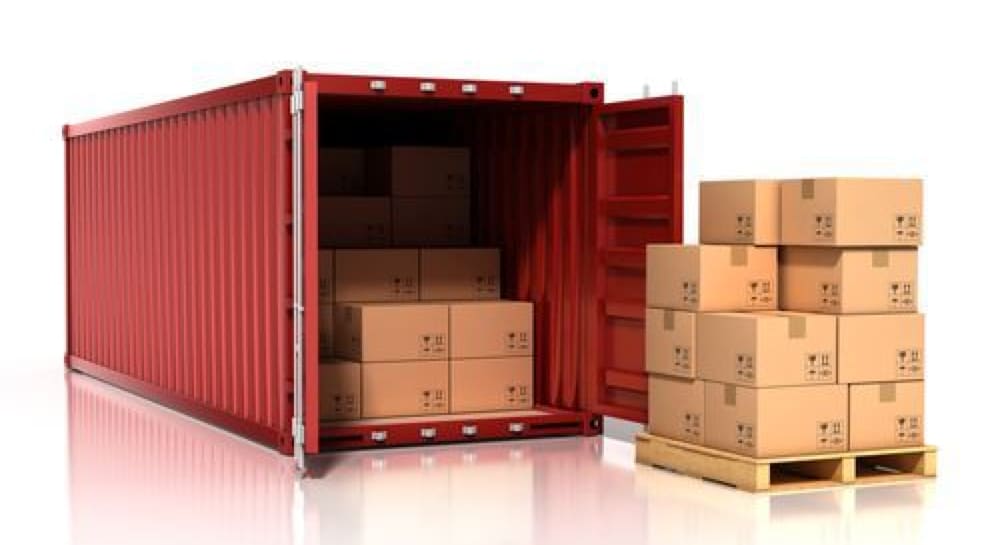
Nominal container volumes are useful, but practical usable CBM is lower due to door frames, corrugation, tie bars, dunnage, pallet inefficiency, and loading gaps.
Typical internal dimensions and nominal volumes (approximate ranges from container equipment references):
- 20’ GP: ~5.9–6.0 m (L) × ~2.33–2.35 m (W) × ~2.38–2.39 m (H); nominal ~33 m³.
- 40’ GP: ~12.0 m × ~2.33 m × ~2.38 m; nominal ~67–68 m³.
- 40’ High Cube (HC/HQ): ~12.0 m × ~2.35 m × ~2.69 m; nominal ~76 m³.
You can find consolidated charts and PDFs from logistics providers, for example: OMNI Logistics’ equipment sheet provides internal sizes and capacities across common container types in a downloadable format: OMNI Logistics ocean container specifications.
Another equipment overview, useful for cross-checking typical ranges including door openings and payloads, is Beequip’s guide to shipping container dimensions.
Practical notes:
- Usable volume is typically 90–95% of nominal due to structural intrusions and loading gaps.
- Pallet choice affects how efficiently you fill width and length. EUR 800 × 1200 mm, ISO 1000 × 1200 mm, and US 48 × 40 in pallets pattern differently in a 2,350 mm internal width.
- Floor loading (no pallets) can increase carton count but may increase handling/damage risk and complicate receiver requirements.
Back-of-envelope usable CBM:
- 20’ GP often yields ~28–31 m³ of “usable” space for mixed cartons.
- 40’ GP often yields ~60–64 m³.
- 40’ HC often yields ~70–73 m³.
These are planning heuristics; actual results depend on carton sizes, orientation, dunnage, and receiver constraints.
5) LCL vs FCL: billing logic and a practical break-even framework
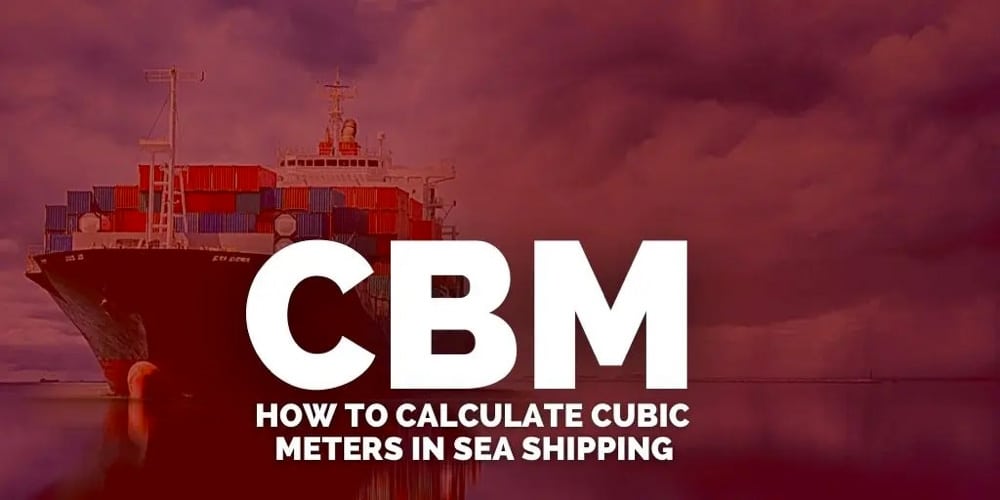
5.1 What’s in the bill
- LCL typically includes: per-W/M ocean freight, origin handling and documentation, CFS fees, destination deconsolidation/handling, documentation, sometimes warehousing and mandatory palletization. Many of these scale by CBM with minimums.
- FCL typically includes: an all-in ocean rate for the container, origin/destination terminal handling charges (THC), documentation, surcharges (e.g., BAF/CAF), chassis/drayage, and possibly demurrage/detention if time limits are exceeded.
5.2 Break-even heuristic
A simple way to compare:
Break-even CBM ≈ (All-in landed cost of a 20’ FCL on your lane) ÷ (End-to-end LCL cost per CBM on the same lane)
Example (illustrative):
- Suppose your LCL end-to-end cost is ~$150 per CBM (including typical origin/destination handling) and a door-to-door 20’ FCL is ~$2,500.
- Break-even ≈ $2,500 ÷ $150 ≈ 16.7 CBM.
Caveats:
- Include local delivery/trucking in both scenarios. LCL might include per-CBM destination handling that FCL does not, whereas FCL adds full-truck delivery costs.
- On some lanes, break-even for 40’ HC might be in the high 20s to low 30s CBM. Rate volatility will move these thresholds.
- If your shipments are consistent, consider moving to FCL earlier for better control and lower damage risk.
5.3 Practical decision cues
- Consistently above ~14–18 CBM on 20’ lanes? Price out FCL as a control quote.
- Occasional peaks? Consolidate POs or adjust production cadence to cross the break-even intelligently.
- Heavy cargo with low CBM? Weight limits can be the constraint—validate axle weight and payload caps.
6) Packaging and palletization strategies to reduce CBM
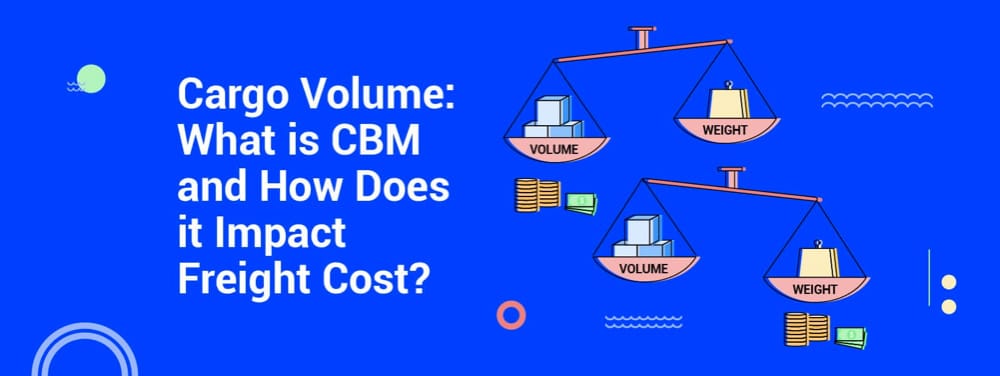
Small dimensional changes compound across hundreds of cartons. Aim for fewer voids, repeatable carton modules, and pallet patterns that fit container geometry.
6.1 Right-size outer cartons and dunnage
- Design outer cartons to minimize empty space and standardize sizes into a small set of modules that tile well on pallets and in containers.
- A practical guide to pallet optimization principles—modular sizes, layer patterns, and stability—comes from packaging engineers; see GWP Group’s overview of pallet optimisation tips.
6.2 Pallet footprint and orientation
- Common pallets: EUR/EPAL 800 × 1200 mm; ISO/UK 1000 × 1200 mm; US 48 × 40 in (~1219 × 1016 mm).
- Test patterns that minimize unused width (e.g., two EUR pallets crosswise often fit a container width well). Rotate cartons to find the densest, stable pattern.
6.3 Stack height and stability
- Aim high but safe. Many receivers cap height around 1.6–1.8 m; confirm retailer/DC limits.
- Use corner protection, proper stretch-wrap, and top caps to stabilize taller stacks without increasing the footprint.
6.4 Avoid overhang and deformation
- Overhanging cartons increase the measured L/W, can lead to rework fees, and raise damage risk. Packaging equipment makers document the link between overhang and damage; see Lantech’s guidance on reducing shipping damage.
6.5 Use software and 3D optimizers
- Cartonization and load-planning tools help you evaluate alternate carton sets, layer patterns, and container load plans. Even a spreadsheet model with a few carton modules can reveal large CBM savings.
6.6 Consolidation and cadence
- Combine POs or SKUs to fill a 20’ when close to break-even. If demand allows, shift to monthly FCL cycles to stabilize freight cost and reduce handling.
7) Edge cases and risk management
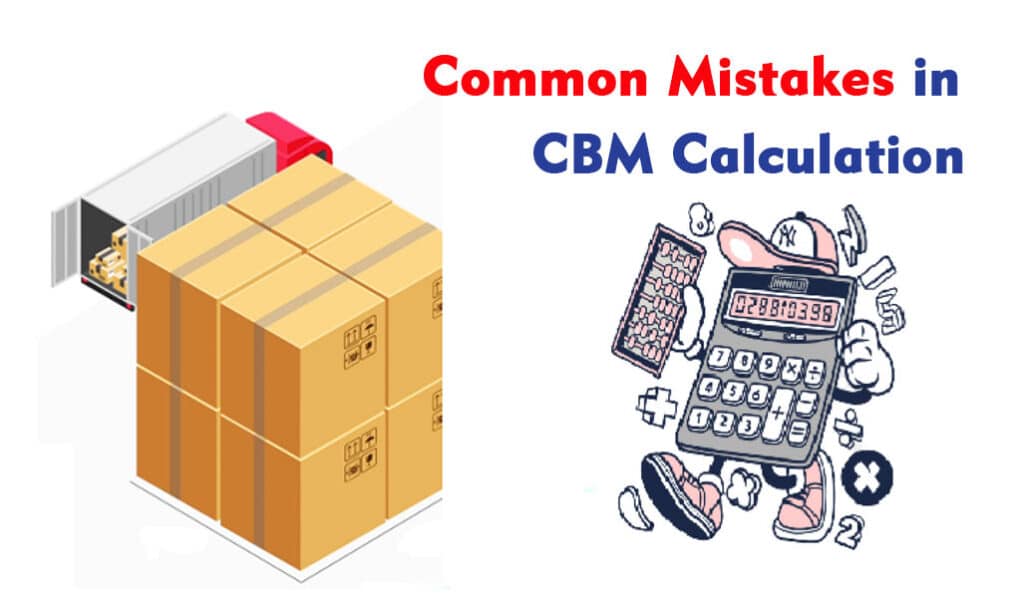
7.1 Irregular cargo and bounding boxes
If your item isn’t a neat rectangle, many CFS/terminals and carriers will rate using the maximum L × W × H that encloses the piece. This protects against underdeclared dimensions and simplifies handling.
7.2 Palletized mixed cartons (how it’s measured)
Even if your internal math sums per-carton CBM, expect terminals to rate a unitized pallet by its full external dimensions, including the pallet base and any bulge or overhang. That’s the number that drives chargeable CBM.
7.3 Remeasurement rights and disputes
Most carriers and forwarders reserve the right to reweigh and remeasure shipments at acceptance and at hubs. If variance is found, they can rebill using their measurements.
This is spelled out in carrier tariffs, such as Landstar’s published rules for air freight that explicitly reserve reweigh/remeasure rights: Landstar Air Freight Rules Tariff (PDF) (2022, still commonly referenced in 2025).
Mitigation checklist:
- Measure with a calibrated tape and record photos with the tape visible on L, W, and H.
- Include detailed packing lists with dimensions and weights for each handling unit.
- Ask your forwarder how they round and what tolerances they apply.
- If a large variance occurs, request a recheck and compare measurement methods (e.g., bounding box vs geometric formula).
8) Worked examples you can copy
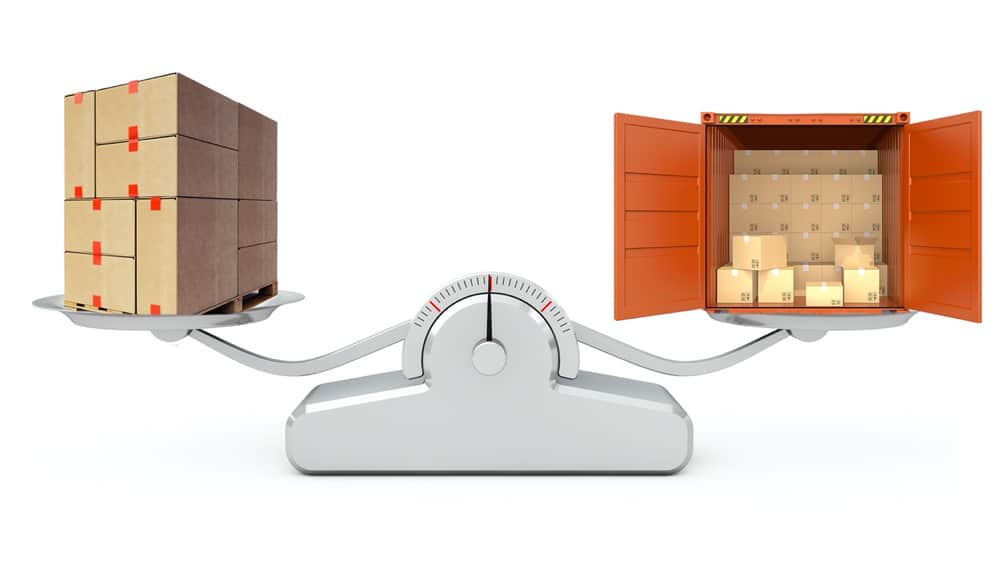
These scenarios mirror the decisions B2B importers make weekly.
Example A: Single carton, multi-carton, and palletized
- Single carton: 62 × 42 × 36 cm → 0.620 × 0.420 × 0.360 m = 0.094 CBM (rounded to three decimals).
- 30 identical cartons: 30 × 0.094 = 2.820 CBM total.
- Palletized unit: Two layers of those cartons on a 120 × 100 cm pallet to 150 cm height → 1.20 × 1.00 × 1.50 = 1.800 CBM for that handling unit (used for rating when shipped as a pallet).
What to watch: The palletized CBM is not the sum of inner cartons—it’s the external size of the unit. If your cartons bulge beyond the pallet, your L/W increases and so does chargeable CBM.
Example B: Air vs sea chargeable weight for the same shipment
Shipment: 0.80 CBM of consumer goods, gross weight 95 kg.
- Air (DIM): 0.80 m³ = 800,000 cm³ → 800,000 ÷ 6,000 = 133.3 kg dimensional. Chargeable = max(95, 133.3) = 133.3 kg.
- LCL (W/M): Compare 0.80 CBM vs 0.095 ton → charge on 0.80 W/M.
Interpretation: Air charges on 133.3 kg; LCL charges on 0.80 W/M. Depending on your lane’s per‑kg air rate vs per‑W/M LCL rate (plus handling), the economics may flip quickly. As a rule, bulky low-density goods tilt toward ocean.
Example C: LCL → FCL break-even on a China → U.S. West Coast lane
Assumptions (illustrative):
- LCL end-to-end effective cost ≈ $150 per CBM (ocean + typical handling both sides).
- A door-to-door 20’ FCL quote ≈ $2,400.
Break-even CBM ≈ $2,400 ÷ $150 = 16.0 CBM.
- If your forecast is 12–14 CBM monthly, you might stay LCL or consolidate bimonthly to hit FCL.
- At 18–22 CBM on most cycles, request FCL quotes; even if a single LCL looks cheaper on ocean alone, the per‑CBM handling fees and higher damage risk often tip the decision toward FCL.
9) Practical FAQs (beyond the basics)
1. Do I measure inner or outer carton size?
Always outer. Carriers rate the space your package occupies.
2. How many CBM fit in a 40’ HQ?
Nominal is ~76 m³, but plan on ~70–73 m³ usable for mixed cartons. Verify with your specific carton mix and load plan.
3. For air, do all carriers use 6,000 cm³/kg?
It’s the standard convention described by carriers like DHL and Air Canada for general cargo. Specialized products or contracts can differ—always check your airway bill terms.
4. For express, is 139 in³/lb universal?
It’s common, and FedEx documents it for applicable services in 2025, but divisors can vary by service and account. Confirm in your current guide.
5. My supplier’s dimensions changed at loading—now what?
Update the booking with new CBM immediately. If the terminal remeasures higher, expect rebilling. Collect photo evidence for any dispute.
6. Should I palletize or floor-load?
Floor-loading can increase usable space and reduce CBM per unit, but palletizing improves handling and reduces damage. Consider receiver requirements, damage risk, and labor on both ends.
7. Does heavier always mean more cost at sea?
In LCL, you pay by the higher of CBM or metric tons. For dense goods, weight may dominate; for bulky goods, CBM dominates.
10) Quick reference (keep near your pack list)
- Rectangular CBM: L × W × H (in meters). Round to three decimals.
- Air DIM: L × W × H (cm) ÷ 6,000 → chargeable weight is max(actual, DIM). See carrier guidance like DHL and Air Canada for the 6,000 rule.
- Express DIM: Volume (in³) ÷ 139 lb (often; verify in your current service guide).
- LCL W/M: Charge on the greater of CBM or metric tons (1 CBM = 1,000 kg convention).
- 40’ HC planning: ~70–73 m³ usable for mixed carton loads (varies with carton sizes and orientation).
- Remeasure risk: Provide dimensioned photos and detailed pack lists; expect carriers to reweigh/remeasure.
11) Credible references for your team
- The 6,000 cm³/kg air divisor and how “chargeable weight” works are explained by carriers such as DHL eCommerce Canada (2025) and corroborated by Air Canada Cargo’s dimensional weight FAQ (2025).
- Express parcel dimensional weight divisors are documented in carrier service guides, e.g., the FedEx U.S. Service Guide 2025.
- The LCL W/M convention (1 CBM = 1,000 kg) is described in forwarder education resources like DocShipper’s chargeable vs dimensional weight guide and IntoGLO’s per W/M overview.
- Container interior dimensions and capacities are summarized in equipment sheets such as OMNI Logistics’ ocean container specifications (PDF) and cross-checked against industry overviews like Beequip’s container dimensions guide.
- Packaging efficiency and pallet patterning are covered in GWP Group’s pallet optimisation tips, while avoiding overhang and protecting loads is emphasized by Lantech’s damage reduction guide.
- For reweigh/remeasure policies and dispute posture, see the Landstar Air Freight Rules Tariff (PDF) detailing rights to remeasure and rebill.
Note: Each resource is used once here; for ongoing operations, bookmark the ones most relevant to your lanes and modes.
Next steps
- If you’re consistently shipping 12–20 CBM per cycle, run both LCL and 20’ FCL quotes and include local delivery in both. Model your carton modules and pallet patterns—small changes here often pay back fast.
- Not sure where to start? Book a 15‑minute consult to review your carton sizes, palletization, and lane pricing. Yansourcing can help plan packaging and coordinate freight so you’re paying for the space you actually need.
- Prefer a neutral path? Share this guide with your current forwarder and ask them to validate your DIM and W/M assumptions, then request a side-by-side LCL vs FCL plan for your next three shipments.
